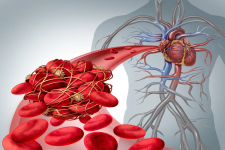Mr.Testosterone
Newbie
- Thread Author
- #1
Anabolic androgenic steroids AAS are synthetic compounds that share a similar structure to testosterone, a natural hormone in the body. Although they have important medical value for treating certain conditions, their use has spread widely beyond the doctor's office. Today, many peoople use them for non-medical reasons, whether in sports to improve performance or to achieve aesthetic changes.
What's important to understand is that AAS are potent and their effects extend throughout the body. One of the key aspects to consider is how they interact with our hematological (blood) system and clotting mechannisms. Understanding these effects is critical, as they have a direct connection to the health of our cardiovascular system.
Increase in Hematocrit and Hemoglobin
-AAS use stimulates erythropoiesis byy.
-Increasing endogenous erythropoietin (EPO), partly by mimicking renal hypoxia.
-Having a direct effect on hematopoietic stem cells..
Consequences:
A hematocrit level >52% in men can increase blood viscosity, reduce blood flow, and significantly raise the risk of thrombosis and cardiovascular events.
Cycle Management
-Shorter cycles
-Avoid prolonged supraphysiological doses
-Use of less erythropoietic compounds (e.g., avoid HIGH doses of Boldenone etc))
-Avoid excessive stacking (multiple AAS combinations)
-Implement adequate time off between cycles and an effective Post-Cycle Therapy (PCT) to allow physiological recovery and normalization of parameters
Supplementation and Diet
- Omega-3 fatty acids: anti-inflammatory and antithrombotic properties
- Niacin (vitamin B3): can improve lipid profile
- Garlic (Allium sativum)
- Be careful with multivitamins. We tend to have meat-rich diets annd often take multivitamins that add more iron to our diet.
- Coenzyme Q10 (CoQ10)
Understanding how they work, understanding their dangers, and implementing mitigation strategies are crucial steps to staying healthy.

Reference
What's important to understand is that AAS are potent and their effects extend throughout the body. One of the key aspects to consider is how they interact with our hematological (blood) system and clotting mechannisms. Understanding these effects is critical, as they have a direct connection to the health of our cardiovascular system.
Increase in Hematocrit and Hemoglobin
-AAS use stimulates erythropoiesis byy.
-Increasing endogenous erythropoietin (EPO), partly by mimicking renal hypoxia.
-Having a direct effect on hematopoietic stem cells..
Consequences:
- ↑ Hematocrit (Hct)
- ↑ Hemoglobin (Hb)
- ↑ Red blood cell count (RBC)
A hematocrit level >52% in men can increase blood viscosity, reduce blood flow, and significantly raise the risk of thrombosis and cardiovascular events.
Changes in Coagulation Factors
Several studies have shown that AAS can alter coagulation mechanisms:- ↑ Fibrinogen.
- ↑ Platelet activity, enhancing platelet aggregation.
- ↑ Procoagulant factors (e.g., Factor VII)..
Altered Lipid Profile
While not a direct hematological parameter, AAS use leads to: - ↓ HDL (“good” cholesterol)

- ↑ LDL (“bad” cholesterol)

Mitigation Strategies
Regular monitoring is essential, with frequency depending on dosage, cycle length, and individual risk factors:- Hematocrit and hemoglobin: every 6–9 weeks during the cycle
- Lipid profile: LDL, HDL, triglycerides
- Coagulation times: PT, aPTT, INR
- Blood pressure
Blood Donation
In cases where hematocrit exceeds 52%, therapeutic phlebotomy or voluntary blood donation—always under strict medical supervision—can reduce the risk of hyperviscosity. (This isn't a solution, but when it goes over 52%, assuming you're very hydrated, it's a quick way to reduce it and take action.)Cycle Management
-Shorter cycles
-Avoid prolonged supraphysiological doses
-Use of less erythropoietic compounds (e.g., avoid HIGH doses of Boldenone etc))
-Avoid excessive stacking (multiple AAS combinations)
-Implement adequate time off between cycles and an effective Post-Cycle Therapy (PCT) to allow physiological recovery and normalization of parameters
Supplementation and Diet
- Omega-3 fatty acids: anti-inflammatory and antithrombotic properties
- Niacin (vitamin B3): can improve lipid profile
- Garlic (Allium sativum)
- Be careful with multivitamins. We tend to have meat-rich diets annd often take multivitamins that add more iron to our diet.
- Coenzyme Q10 (CoQ10)
Understanding how they work, understanding their dangers, and implementing mitigation strategies are crucial steps to staying healthy.
Reference
- Glazer, G. (1991). Atherogenic effects of anabolic steroids on serum lipid levels. A literature review. Archives of Internal Medicine, 151(10), 1925–1933.
- Sader MA et al. (2001). Androgenic anabolic steroids and arterial structure and function in male bodybuilders. Journal of Clinical Endocrinology & Metabolism, 86(6), 3070–3073.
- Baggish AL, et al. (2017). Long-term anabolic-androgenic steroid use is associated with left ventricular dysfunction. Circulation: Heart Failure, 10(5).
- Thiblin, I., & Petersson, A. (2005). Pharmacological anabolic androgenic steroids and violence. Current Opinion in Psychiatry, 18(2), 183–188.
